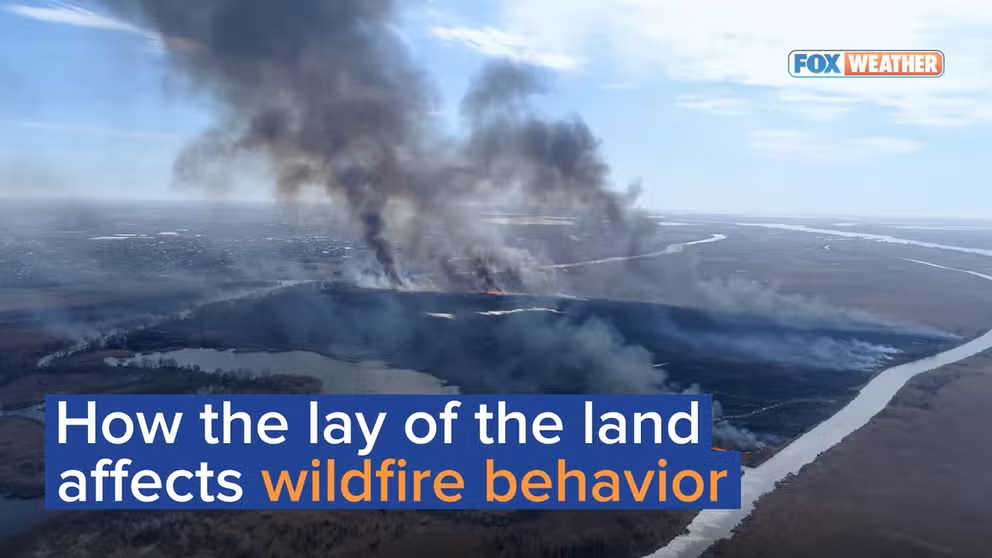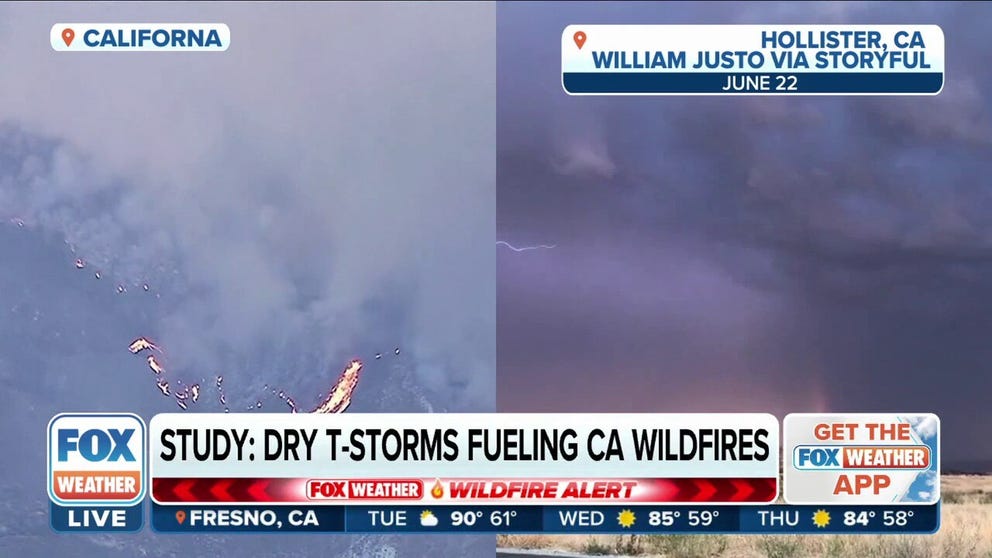Why dry thunderstorms pose wildfire, dust storm risks
Dry lightning is the main cause of wildfires in Central and Northern California.
How the lay of the land affects wildfire
It's not just the weather and the flames that challenge firefighters during a wildfire, but the topography can play a big role in the fire's behavior.
Residents of the western United States frequently see the term "dry thunderstorm" or "dry lightning" in their weather forecasts – particularly from late spring into summer – referring to lightning-producing storms with little or no rainfall. But these storms pose a problem: Lightning without rain can be a recipe for disaster.
A dry thunderstorm has a high cloud base, which is a key component of this type of storm because it requires the rain to fall through a very deep layer of the atmosphere before it can reach the ground.
In the western U.S., the air is typically very dry. Since the raindrops have such a long way to travel from the high-based cloud down to the Earth’s surface, they will evaporate in that dry air before making it to the ground, so the thunderstorm brings very little, if any, rainfall to the surface. Meteorologically speaking, this is called "virga."
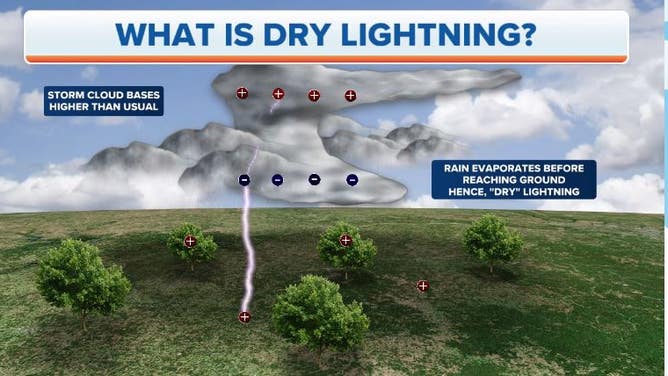
This graphic illustrates the science behind dry lightning.
(FOX Weather)
Thunderstorms don’t need rain to produce lightning, however. Cloud-to-ground lightning can strike the surface and spark a wildfire, especially if the vegetation is dry. Gusty winds associated with the thunderstorm can then fan the flames and cause the fire to quickly grow out of control.
HOW THE LAY OF THE LAND AFFECTS WILDFIRE BEHAVIOR
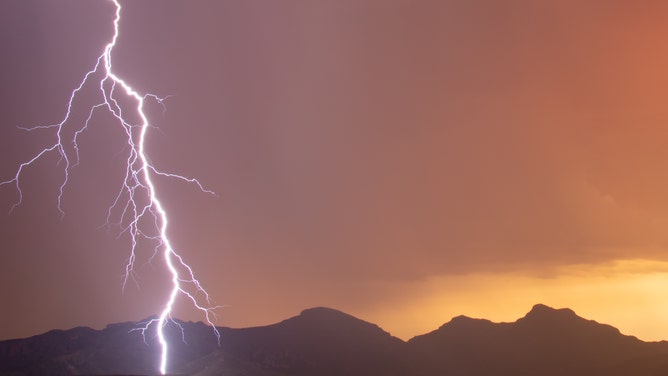
Dry lightning is photographed in Rio Rico, Arizona.
(Christopher Scragg)
NOAA’s Storm Prediction Center produces forecasts for dry thunderstorms and dry lightning in its fire weather outlooks. The "true" National Weather Service definition of a dry thunderstorm is a storm that produces at least one cloud-to-ground lightning strike with less than 0.10 inches of precipitation.
However, the SPC also considers up to 0.25 inches of rainfall to be a dry thunderstorm, as long as it’s accompanied by at least one cloud-to-ground lightning strike. Storms with greater than 0.25 inches of precipitation tend to produce "wetting rains" and are then considered "wet thunderstorms," the SPC said.
The fire risk depends on weather conditions before and after a dry thunderstorm. If soils are dry, there’s a higher chance that dry lightning could spark a wildfire. The odds are lower if recent rains have dampened the vegetation.
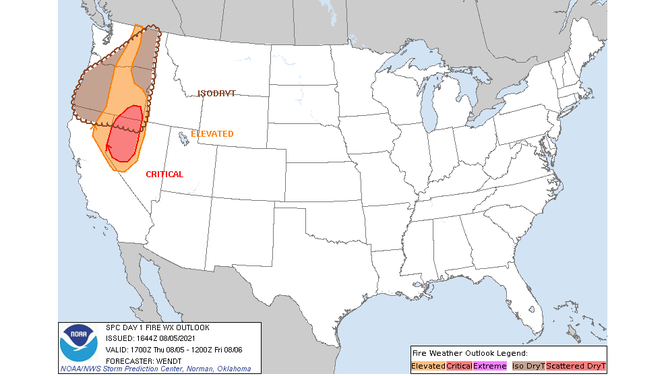
NOT A CURRENT FORECAST – The Fire Weather Outlook for Aug. 5, 2021, issued by NOAA's Storm Prediction Center showed isolated dry thunderstorms (denoted by ISODRYT) in the forecast for parts of the Northwest.
(NOAA's Storm Prediction Center)
It should be noted that any thunderstorm – dry or wet – brings fire concerns because of the cloud-to-ground lightning it can produce.
DEBUNKING 7 MYTHS ABOUT LIGHTNING
"Lightning can and does start wildfires virtually anywhere outside the western U.S. from what would not normally be considered a ‘dry storm,’" the SPC said.
Any lightning that strikes the ground outside the main area of rain (or evaporating rain) from both wet and dry thunderstorms can also start wildfires.
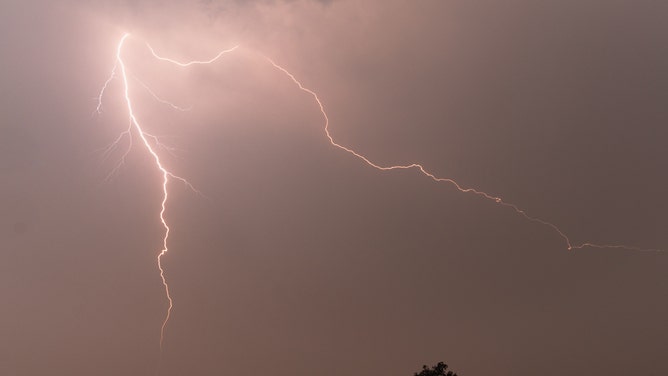
Dry lightning is obscured by thick smoke in Oregon.
(Christopher Scragg)
Additionally, a dry thunderstorm can sometimes be the catalyst of a dust storm – also called a haboob – if its winds are strong enough to pick up large amounts of dust.
WHAT IS A HABOOB? IT'S JUST DUST IN THE WIND…
Inside a dust storm, the sky typically turns a dark-orange color from the dust, and visibilities can quickly drop to near zero, causing extremely dangerous conditions along freeways and highways.
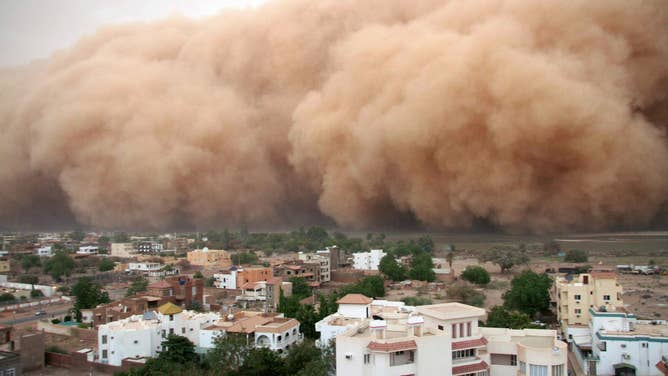
A gigantic cloud of dust known as "haboob" advances over Khartoum, the capital of Sudan, on April 29, 2007.
(STR / AFP / Getty Images)
Several California wildfires have been sparked by dry lightning
A study released in August 2022 found that nearly half of all cloud-to-ground lightning strikes in California between May and October were associated with dry thunderstorms over the period from 1987 through 2020.
The research team, led by Washington State University Vancouver Ph.D. student Dmitri Kalashnikov, noted that human-caused wildfire ignitions are most common in Southern California, but in Central and Northern California, lightning is the main cause of wildfires – especially over mountainous terrain.
HOW WILDFIRE BURN SCARS COULD HAVE LASTING IMPACTS
Study: Dry lightning sparks some of the most destructive, costly wildfires in California
Study finds that dry lightning sparks some of the most destructive and costly wildfires in California. Dmitri Kalashnikov, Ph.D. student at Washington State University Vancouver, talks more about the study.
According to the study, dry lightning has sparked several of California's largest, costliest and most destructive wildfires because of the lightning's overlap with dense, dry vegetation and a large population living adjacent to fire-prone lands.
The state's historic August Complex Fire in 2020 was sparked by an outbreak of dry thunderstorms with frequent cloud-to-ground lightning across Northern California. This record-breaking blaze was California's first "gigafire," a wildfire that burns more than 1 million acres of land. The August Complex Fire scorched an area larger than Rhode Island.
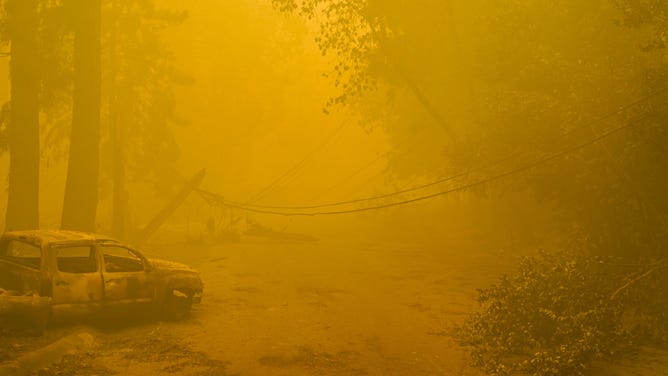
Smoke hangs low in the air along Highway 236 on Saturday, Aug. 22, 2020, in Boulder Creek, California. The August Complex Fire tore through Big Basin Redwoods State Park, decimating the 118-year-old state park, California's oldest.
(Kent Nishimura / Los Angeles Times / Getty Images)
